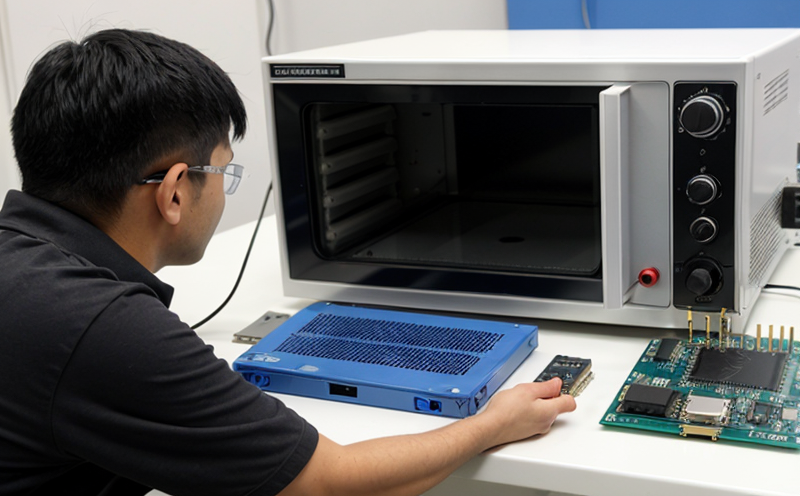ANSI EIA 364 Connector Mechanical Testing for Microelectronics
The ANSI EIA 364 series of standards provides a comprehensive framework for testing connectors used in microelectronics. The Ansi Eia 364-1987 connector mechanical test method standard specifically addresses the physical and mechanical performance requirements that ensure the reliability, durability, and interchangeability of connectors within this critical sector.
The ANSI EIA 364-1987 standard is widely recognized for its rigorous approach to evaluating the structural integrity of connectors. This includes assessing factors such as force required for insertion and extraction, pullout strength, resistance to vibration and shock, and resistance to environmental stresses like humidity and temperature extremes.
Compliance with these standards ensures that microelectronic components can withstand the rigors of manufacturing processes and field use, enhancing overall product performance and reducing failure rates. The testing protocol is designed to simulate real-world conditions, providing insights into potential weaknesses in design or manufacturing.
The testing methodology involves several key steps:
- Specimen preparation: This includes cleaning the connector according to specified guidelines to ensure accurate measurement results.
- Force application: Measuring and recording the force required for insertion and extraction of the connector.
- Vibration testing: Subjecting the specimen to controlled vibration levels to assess its stability under dynamic conditions.
- Shock testing: Evaluating the connector’s ability to withstand sudden impacts without failing.
- Environmental stress tests: Exposing the connector to various environmental conditions like humidity and temperature cycling to ensure long-term reliability.
The ANSI EIA 364-1987 standard is particularly relevant for connectors used in high-reliability applications, such as aerospace, automotive electronics, and medical devices. These sectors demand connectors that can operate reliably under extreme conditions without compromising on performance or safety.
| Use Case | Description |
|---|---|
| Aerospace Industry | Testing connectors used in avionics systems to ensure they can withstand the harsh environmental conditions of space travel and air travel. |
| Automotive Electronics | Evaluating connectors for use in automotive wiring harnesses to ensure durability under high vibration and temperature fluctuations during vehicle operation. |
| Military Applications | Ensuring that connectors used in military equipment can withstand the rigorous operational environments, including extreme temperatures and mechanical stress. |
| Medical Devices | Testing connectors for use in medical devices to ensure they meet stringent reliability standards required in healthcare settings. |
The ANSI EIA 364-1987 standard is not only crucial for ensuring the mechanical integrity of microelectronics but also plays a vital role in facilitating interoperability among different manufacturers. By adhering to these standards, companies can ensure that their products are compatible with existing and future systems, thereby fostering innovation and reducing barriers to market entry.
Quality and Reliability Assurance
The ANSI EIA 364-1987 standard is integral to the quality assurance process in microelectronics manufacturing. It provides a standardized approach to testing that helps manufacturers identify potential issues early in the product lifecycle, thereby reducing the cost of rework and improving overall product quality.
- Inspection: Ensuring that connectors conform to design specifications before they are subjected to mechanical tests.
- Tolerance levels: Establishing acceptable ranges for critical dimensions such as contact spacing and pin diameter to prevent manufacturing defects from affecting performance.
- Data analysis: Using the results of mechanical tests to refine production processes and improve product reliability.
By implementing ANSI EIA 364-1987, manufacturers can ensure that their connectors meet or exceed industry standards. This not only enhances customer satisfaction but also helps in maintaining a strong reputation within the market.
International Acceptance and Recognition
The ANSI EIA 364-1987 standard is internationally recognized for its robustness and relevance. It has been adopted by numerous organizations worldwide, including the International Electrotechnical Commission (IEC) and the European Committee for Standardization (CEN).
- ISO/IEC: The ISO 20654 series of standards, which incorporate elements from ANSI EIA 364, have been widely accepted globally.
- CEN/CENELEC: The European standards for connectors are often aligned with the ANSI EIA 364 specifications to ensure compatibility and interoperability across borders.
Adherence to ANSI EIA 364-1987 ensures that microelectronics manufacturers can meet the rigorous quality and reliability requirements of international markets. This standardization fosters global trade and collaboration, enabling companies to operate efficiently in a competitive global environment.
Use Cases and Application Examples
The ANSI EIA 364-1987 connector mechanical testing standard finds application in various sectors where reliability and performance are paramount. Below are some specific use cases:
| Application | Description |
|---|---|
| Avionics Systems | Evaluating connectors for use in avionics systems to ensure they can withstand the extreme conditions of space travel and air travel. |
| Automotive Wiring Harnesses | Testing connectors used in automotive wiring harnesses to ensure durability under high vibration and temperature fluctuations during vehicle operation. |
| Military Equipment | Evaluating the mechanical integrity of connectors for use in military equipment, ensuring they can withstand rigorous operational environments. |
| Medical Devices | Testing connectors used in medical devices to ensure they meet stringent reliability standards required in healthcare settings. |
In addition to these sectors, ANSI EIA 364-1987 is also applicable in consumer electronics, industrial equipment, and telecommunications. The standard ensures that microelectronics components can operate reliably under a wide range of conditions, enhancing the overall performance and safety of devices.





